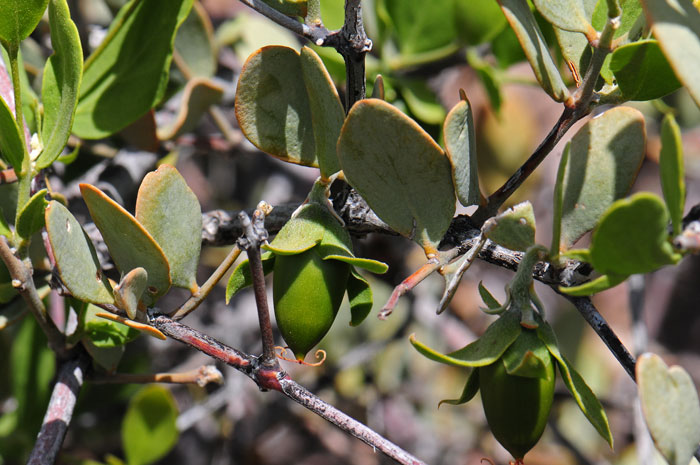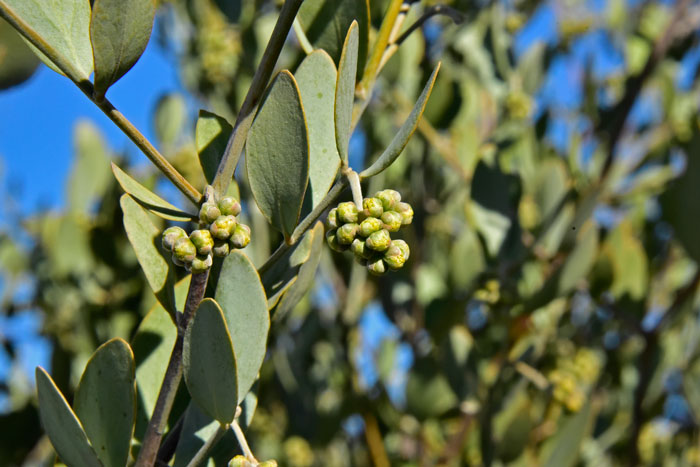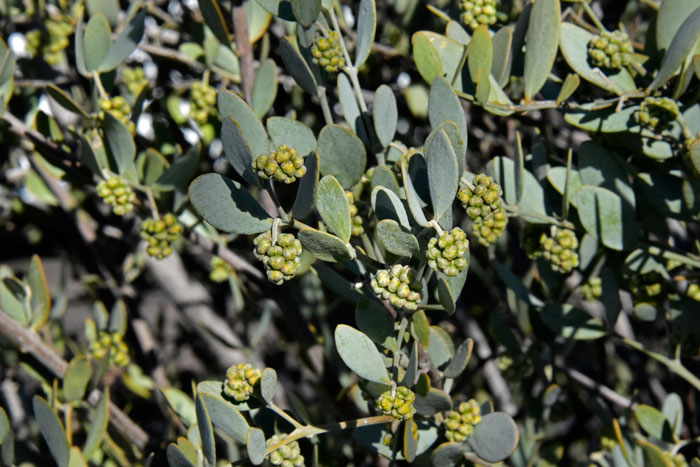Simmondsia chinensis, Jojoba



Scientific Name: Simmondsia chinensis
Common Name: Jojoba
Also Called: Coffee Berry, Deer Nut, Goat Nut, Gray Box Bush, Pignut, Quinine Nut and Wild Hazel (Spanish: Jojoba)
Family: Simmondsiaceae or Jojoba Family
Synonyms: (Buxus chinensis, Simmondsia californica)
Status: Native
Duration: Perennial
Size: Up to 6 feet or so, usually much less.
Growth Form: Shrub; plants with multiple erect stiff branches; new growth pubescent; plants handsome.
Leaves: Green, bluish-green, dull green; evergreen-like; sub-sessile; opposite; thick leathery; margins simple; leaf shape variable oblong-ovate
Flower Color: Yellowish; flowers on short peduncled; flowers unisexual, male and female flowers on separate plants, fruit an ovoid leathery capsule, looks like an acorn.
Flowering Season: December to July; March to May in California.
Elevation: 1,000 to 5,000 feet in Arizona and California.
Habitat Preferences: Common to abundant; dry slopes and along washes.
Recorded Range: Simmondsia chinensis is relatively rare in the United States where it is limited to Arizona, California and Utah. In Utah it is found in Utah and Washington counties, mostly southeast California and the south ½ of Arizona. It has large populations in Baja California and northwest Mexico.
North America & US County Distribution Map for Simmondsia chinensis.
U.S. Weed Information: No information available.
Invasive/Noxious Weed Information: No information available.
Wetland Indicator: No information available.
Threatened/Endangered Information: No information available.
Comments: Simmondsia chinensis is a popular shrub for desert landscapes. Several years ago Jojoba was emerging as commercial crop popular for its jojoba oil which were promising for a variety of purposes including cosmetics, cooking oils and as a car wax. It is an attractive plant that needs little water once established. Jojoba is readily browsed by deer and livestock.
Simmondsia chinensis has been used for food and other purposes South American indigenous peoples.
Cahuilla Food, Beverage, Seeds eaten fresh or ground into powder and used to make a coffee like beverage.
Cocopa Food, Bread & Cake, Kernels molded into oily cake, boiled and eaten.
Papago Food, Unspecified, Nuts eaten fresh from the shell.
Papago Drug, Dermatological Aid, Poultice of dried and pulverized nuts applied to sores.
Yavapai Drug, Cathartic, Plant yielded oily food with cathartic qualities.
Yavapai Food, Preserves, Berries parched and ground to consistency of peanut butter.
See ethno-botanical uses at Native American Ethnobotany, University of Michigan, Dearborn.

